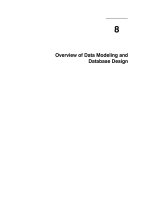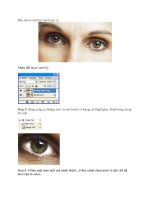Tài liệu Solution of Linear Algebraic Equations part 6 pptx
Bạn đang xem bản rút gọn của tài liệu. Xem và tải ngay bản đầy đủ của tài liệu tại đây (158.15 KB, 5 trang )
2.5 Iterative Improvement of a Solution to Linear Equations
55
Sample page from NUMERICAL RECIPES IN C: THE ART OF SCIENTIFIC COMPUTING (ISBN 0-521-43108-5)
Copyright (C) 1988-1992 by Cambridge University Press.Programs Copyright (C) 1988-1992 by Numerical Recipes Software.
Permission is granted for internet users to make one paper copy for their own personal use. Further reproduction, or any copying of machine-
readable files (including this one) to any servercomputer, is strictly prohibited. To order Numerical Recipes books,diskettes, or CDROMs
visit website or call 1-800-872-7423 (North America only),or send email to (outside North America).
A
A
−
1
δx
x
+ δx
x
b
b + δb
δb
Figure 2.5.1. Iterative improvement of the solution to A · x = b. The first guess x + δx is multiplied by
A to produce b + δb. The known vector b is subtracted, giving δb. The linear set with this right-hand
side is inverted, giving δx. This is subtracted from the first guess giving an improved solution x.
2.5 Iterative Improvement of a Solution to
Linear Equations
Obviously it is not easy to obtain greater precision for the solution of a linear
set than the precision of your computer’s floating-point word. Unfortunately, for
large sets of linear equations, it is not always easy to obtain precision equal to, or
even comparable to, the computer’s limit. In direct methods of solution, roundoff
errors accumulate, and they are magnified to the extent that your matrix is close
to singular. You can easily lose two or three significant figures for matrices which
(you thought) were far from singular.
If this happens to you, there is a neat trick to restore the full machine precision,
called iterative improvement of the solution. The theory is very straightforward (see
Figure 2.5.1): Suppose that a vector x is the exact solution of the linear set
A · x = b (2.5.1)
You don’t, however, know x. You only know some slightly wrong solution x + δx,
where δx is the unknownerror. When multipliedbythe matrix A, your slightlywrong
solutiongivesa productslightlydiscrepant fromthedesired right-handsideb, namely
A · (x + δx)=b+δb (2.5.2)
Subtracting (2.5.1) from (2.5.2) gives
A · δx = δb (2.5.3)
56
Chapter 2. Solution of Linear Algebraic Equations
Sample page from NUMERICAL RECIPES IN C: THE ART OF SCIENTIFIC COMPUTING (ISBN 0-521-43108-5)
Copyright (C) 1988-1992 by Cambridge University Press.Programs Copyright (C) 1988-1992 by Numerical Recipes Software.
Permission is granted for internet users to make one paper copy for their own personal use. Further reproduction, or any copying of machine-
readable files (including this one) to any servercomputer, is strictly prohibited. To order Numerical Recipes books,diskettes, or CDROMs
visit website or call 1-800-872-7423 (North America only),or send email to (outside North America).
But (2.5.2) can also be solved, trivially, for δb. Substituting this into (2.5.3) gives
A · δx = A · (x + δx) − b (2.5.4)
In this equation, the whole right-hand side is known, since x + δx is the wrong
solution that you want to improve. It is essential to calculate the right-hand side
in double precision, since there will be a lot of cancellation in the subtraction of b.
Then, we need only solve (2.5.4) for the error δx, then subtract this from the wrong
solution to get an improved solution.
An important extra benefit occurs if we obtained the original solution by LU
decomposition. In this case we already have the LU decomposed form of A,andall
we need do to solve (2.5.4) is compute the right-hand side and backsubstitute!
The code to do all this is concise and straightforward:
#include "nrutil.h"
void mprove(float **a, float **alud, int n, int indx[], float b[], float x[])
Improves a solution vector
x[1..n]
of the linear set of equations A · X = B.Thematrix
a[1..n][1..n]
, and the vectors
b[1..n]
and
x[1..n]
are input, as is the dimension
n
.
Also input is
alud[1..n][1..n]
,theLU decomposition of
a
as returned by
ludcmp
,and
the vector
indx[1..n]
also returned by that routine. On output, only
x[1..n]
is modified,
to an improved set of values.
{
void lubksb(float **a, int n, int *indx, float b[]);
int j,i;
double sdp;
float *r;
r=vector(1,n);
for (i=1;i<=n;i++) { Calculate the right-hand side, accumulating
the residual in double precision.sdp = -b[i];
for (j=1;j<=n;j++) sdp += a[i][j]*x[j];
r[i]=sdp;
}
lubksb(alud,n,indx,r); Solve for the error term,
for (i=1;i<=n;i++) x[i] -= r[i]; and subtract it from the old solution.
free_vector(r,1,n);
}
You should note that the routine ludcmp in §2.3 destroys the input matrix as it
LU decomposes it. Since iterative improvement requires both the original matrix
and its LU decomposition, you will need to copyA before calling ludcmp. Likewise
lubksb destroys b in obtaining x, so make a copy of b also. If you don’t mind
this extra storage, iterative improvement is highly recommended: It is a process
of order only N
2
operations (multiply vector by matrix, and backsubstitute — see
discussion following equation 2.3.7); it never hurts; and it can really give you your
money’s worth if it saves an otherwise ruined solution on which you have already
spent of order N
3
operations.
You can call mprove several times in succession if you want. Unless you are
starting quite far from the true solution, one call is generally enough; but a second
call to verify convergence can be reassuring.
2.5 Iterative Improvement of a Solution to Linear Equations
57
Sample page from NUMERICAL RECIPES IN C: THE ART OF SCIENTIFIC COMPUTING (ISBN 0-521-43108-5)
Copyright (C) 1988-1992 by Cambridge University Press.Programs Copyright (C) 1988-1992 by Numerical Recipes Software.
Permission is granted for internet users to make one paper copy for their own personal use. Further reproduction, or any copying of machine-
readable files (including this one) to any servercomputer, is strictly prohibited. To order Numerical Recipes books,diskettes, or CDROMs
visit website or call 1-800-872-7423 (North America only),or send email to (outside North America).
More on Iterative Improvement
It is illuminating (and will be useful later in the book) to give a somewhat more solid
analytical foundation for equation (2.5.4), and also to give some additional results. Implicit in
the previous discussion was the notion that the solution vector x + δx has an error term; but
we neglected the fact that the LU decomposition of A is itself not exact.
A different analytical approach starts with some matrix B
0
that is assumed to be an
approximate inverse of the matrix A,sothatB
0
·Ais approximately the identity matrix 1.
Define the residual matrix R of B
0
as
R ≡ 1 − B
0
· A (2.5.5)
which is supposed to be “small” (we will be more precise below). Note that therefore
B
0
· A = 1 − R (2.5.6)
Next consider the following formal manipulation:
A
−1
= A
−1
· (B
−1
0
· B
0
)=(A
−1
·B
−1
0
)·B
0
=(B
0
·A)
−1
·B
0
=(1−R)
−1
·B
0
=(1+R+R
2
+R
3
+···)·B
0
(2.5.7)
We can define the nth partial sum of the last expression by
B
n
≡ (1 + R + ···+R
n
)·B
0
(2.5.8)
so that B
∞
→ A
−1
, if the limit exists.
It now is straightforward to verify that equation (2.5.8) satisfies some interesting
recurrence relations. As regards solving A · x = b,wherexand b are vectors, define
x
n
≡ B
n
· b (2.5.9)
Then it is easy to show that
x
n+1
= x
n
+ B
0
· (b − A · x
n
)(2.5.10)
This is immediately recognizable as equation (2.5.4), with −δx = x
n+1
− x
n
, and with B
0
taking the role of A
−1
. We see, therefore, that equation (2.5.4) does not require that the LU
decompositon of A be exact, but only that the implied residual R be small. In rough terms, if
the residual is smaller than the square root of your computer’s roundoff error, then after one
application of equation (2.5.10) (that is, going from x
0
≡ B
0
·b to x
1
) the first neglected term,
of order R
2
, will be smaller than the roundoff error. Equation (2.5.10), like equation (2.5.4),
moreover, can be applied more than once, since it uses only B
0
, and not any of the higher B’s.
A much more surprising recurrence which follows from equation (2.5.8) is one that
more than doubles the order n at each stage:
B
2n+1
=2B
n
−B
n
·A·B
n
n=0,1,3,7,... (2.5.11)
Repeated application of equation (2.5.11), from a suitable starting matrix B
0
, converges
quadratically to the unknown inverse matrix A
−1
(see §9.4 for the definition of “quadrati-
cally”). Equation (2.5.11) goes by various names, including Schultz’s Method and Hotelling’s
Method;seePanandReif
[1]
for references. In fact, equation (2.5.11) is simply the iterative
Newton-Raphson method of root-finding (§9.4) applied to matrix inversion.
Before you get too excited about equation (2.5.11), however, you should notice that it
involves two full matrix multiplications at each iteration. Each matrix multiplication involves
N
3
adds and multiplies. But we already saw in §§2.1–2.3 that direct inversion of A requires
only N
3
adds and N
3
multiplies in toto. Equation (2.5.11) is therefore practical only when
special circumstances allow it to be evaluated much more rapidly than is the case for general
matrices. We will meet such circumstances later, in §13.10.
In the spirit of delayed gratification, let us nevertheless pursue the two related issues:
When does the series in equation (2.5.7) converge; and what is a suitable initial guess B
0
(if,
for example, an initial LU decomposition is not feasible)?
58
Chapter 2. Solution of Linear Algebraic Equations
Sample page from NUMERICAL RECIPES IN C: THE ART OF SCIENTIFIC COMPUTING (ISBN 0-521-43108-5)
Copyright (C) 1988-1992 by Cambridge University Press.Programs Copyright (C) 1988-1992 by Numerical Recipes Software.
Permission is granted for internet users to make one paper copy for their own personal use. Further reproduction, or any copying of machine-
readable files (including this one) to any servercomputer, is strictly prohibited. To order Numerical Recipes books,diskettes, or CDROMs
visit website or call 1-800-872-7423 (North America only),or send email to (outside North America).
We can define the norm of a matrix as the largest amplification of length that it is
able to induce on a vector,
R≡max
v
=0
|R · v|
|v|
(2.5.12)
If we let equation(2.5.7) acton some arbitrary right-hand side b, as one wants a matrix inverse
to do, it is obvious that a sufficient condition for convergence is
R < 1(2.5.13)
Pan and Reif
[1]
point out that a suitable initial guess for B
0
is any sufficiently small constant
times the matrix transpose of A,thatis,
B
0
=A
T
or R = 1 − A
T
· A (2.5.14)
To see why this is so involves concepts from Chapter 11; we give here only the briefest
sketch: A
T
· A is a symmetric, positive definite matrix, so it has real, positive eigenvalues.
In its diagonal representation, R takes the form
R = diag(1 − λ
1
, 1 − λ
2
,...,1−λ
N
)(2.5.15)
where all the λ
i
’s are positive. Evidently any satisfying 0 <<2/(max
i
λ
i
) will give
R < 1. It is not difficult to show that the optimal choice for , giving the most rapid
convergence for equation (2.5.11), is
=2/(max
i
λ
i
+min
i
λ
i
)(2.5.16)
Rarely does one know the eigenvalues of A
T
· A in equation (2.5.16). Pan and Reif
derive several interesting bounds, which are computable directly from A. The following
choices guarantee the convergence of B
n
as n →∞,
≤1
j,k
a
2
jk
or ≤ 1
max
i
j
|a
ij
|×max
j
i
|a
ij
|
(2.5.17)
The latter expression is truly a remarkable formula, which Pan and Reif derive by noting that
the vector norm in equation (2.5.12) need not be the usual L
2
norm, but can instead be either
the L
∞
(max) norm, or the L
1
(absolute value) norm. See their work for details.
Another approach, with which we have had some success, is to estimate the largest
eigenvalue statistically, by calculating s
i
≡|A·v
i
|
2
for severalunit vector v
i
’s with randomly
chosendirections in N-space. The largest eigenvalue λ can then be bounded by the maximum
of 2maxs
i
and 2NVar( s
i
)/µ(s
i
), where Var and µ denote the sample variance and mean,
respectively.
CITED REFERENCES AND FURTHER READING:
Johnson, L.W., and Riess, R.D. 1982,
Numerical Analysis
, 2nd ed. (Reading, MA: Addison-
Wesley),
§
2.3.4, p. 55.
Golub, G.H., and Van Loan, C.F. 1989,
Matrix Computations
, 2nd ed. (Baltimore: Johns Hopkins
University Press), p. 74.
Dahlquist, G., and Bjorck, A. 1974,
Numerical Methods
(Englewood Cliffs, NJ: Prentice-Hall),
§
5.5.6, p. 183.
Forsythe, G.E., and Moler, C.B. 1967,
Computer Solution of Linear Algebraic Systems
(Engle-
wood Cliffs, NJ: Prentice-Hall), Chapter 13.
Ralston, A., and Rabinowitz, P. 1978,
A First Course in Numerical Analysis
, 2nd ed. (New York:
McGraw-Hill),
§
9.5, p. 437.
Pan, V., and Reif, J. 1985, in Proceedings of the Seventeenth Annual ACM Symposium on
Theory of Computing (New York: Association for Computing Machinery). [1]
2.6 Singular Value Decomposition
59
Sample page from NUMERICAL RECIPES IN C: THE ART OF SCIENTIFIC COMPUTING (ISBN 0-521-43108-5)
Copyright (C) 1988-1992 by Cambridge University Press.Programs Copyright (C) 1988-1992 by Numerical Recipes Software.
Permission is granted for internet users to make one paper copy for their own personal use. Further reproduction, or any copying of machine-
readable files (including this one) to any servercomputer, is strictly prohibited. To order Numerical Recipes books,diskettes, or CDROMs
visit website or call 1-800-872-7423 (North America only),or send email to (outside North America).
2.6 Singular Value Decomposition
There exists a very powerful set of techniques for dealing with sets of equations
or matrices thatare either singularor else numerically very close to singular. In many
cases where Gaussian elimination and LU decomposition fail to give satisfactory
results, this set of techniques, known as singular value decomposition,orSVD,
will diagnose for you precisely what the problem is. In some cases, SVD will
not only diagnose the problem, it will also solve it, in the sense of giving you a
useful numerical answer, although, as we shall see, not necessarily “the” answer
that you thought you should get.
SVDis also the method of choicefor solvingmostlinear least-squaresproblems.
We will outline the relevant theory in this section, but defer detailed discussion of
the use of SVD in this application to Chapter 15, whose subject is the parametric
modeling of data.
SVD methods are based on the followingtheorem of linear algebra, whose proof
is beyond our scope: Any M × N matrix A whose number of rows M is greater than
or equal to its number of columns N, can be written as the product of an M × N
column-orthogonal matrix U,anN×Ndiagonal matrix W with positive or zero
elements (the singular values), and the transpose of an N × N orthogonal matrix V.
The various shapes of these matrices will be made clearer by the following tableau:
A
=
U
·
w
1
w
2
···
···
w
N
·
V
T
(2.6.1)
The matrices U and V are each orthogonal in the sense that their columns are
orthonormal,
M
i=1
U
ik
U
in
= δ
kn
1 ≤ k ≤ N
1 ≤ n ≤ N
(2.6.2)
N
j=1
V
jk
V
jn
= δ
kn
1 ≤ k ≤ N
1 ≤ n ≤ N
(2.6.3)









